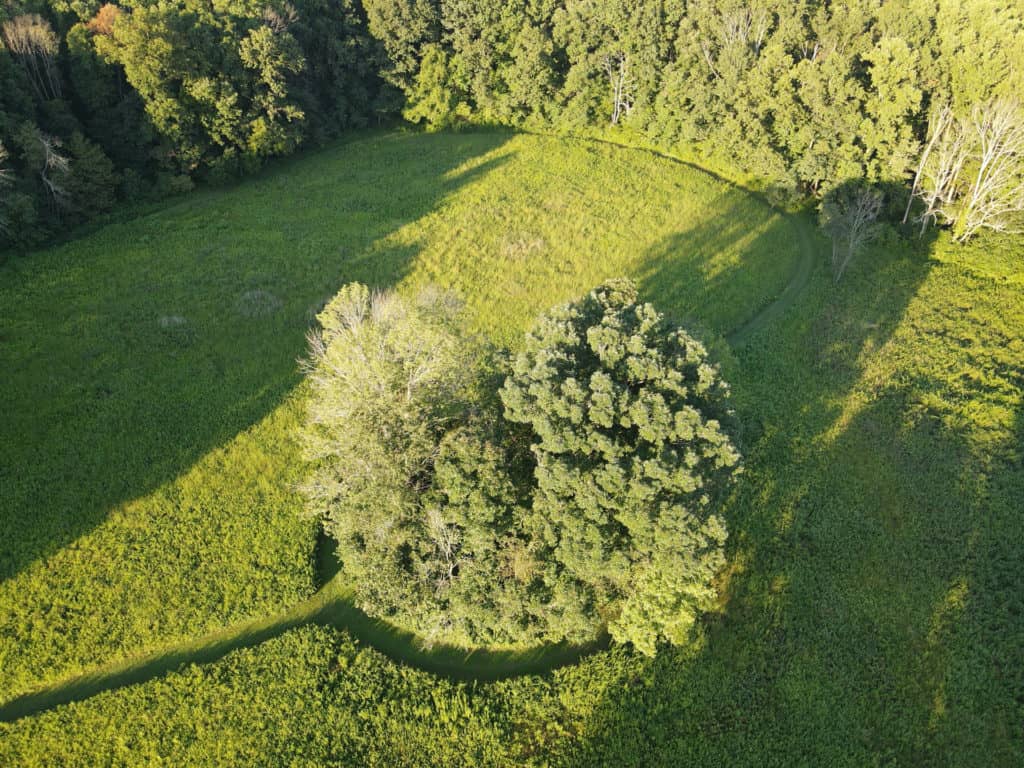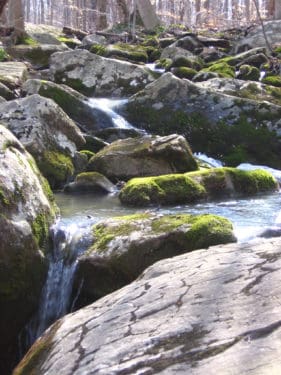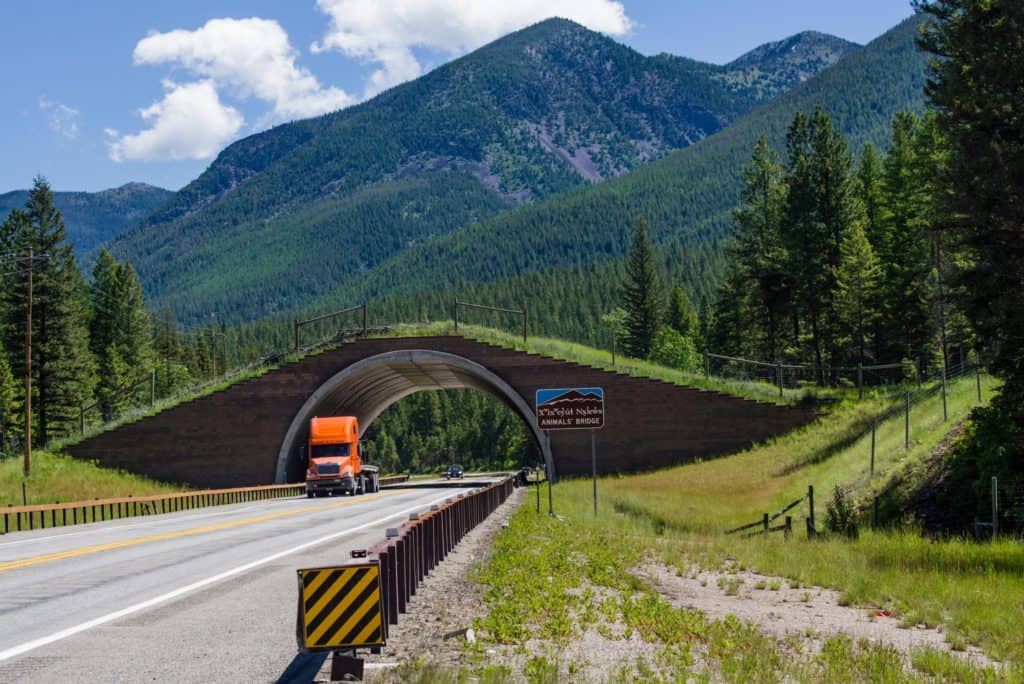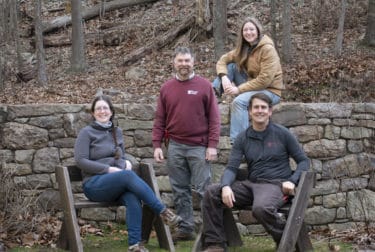an approach of gratitude.
Crow’s Nest Preserve Manager Dan Barringer isn’t sure of the history of Chief’s Grove, a scenic point located in the northern half of the preserve. “We refer to the copse of trees as Chief’s Grove on the map because that’s the name Warwick Township locals have always called it.”

Chief’s Grove at Crow’s Nest Preserve
Photo by Dan Barringer
Over the years, people with ties to local Lenape history and culture have visited the location and suggested it may be the burial location of an elder or healer, perhaps chosen long ago for the stately white oak that dominates the site.
What we do know for sure is that Crow’s Nest Preserve, like all the land that we work to conserve and care for in eastern Pennsylvania and southern New Jersey, was inhabited for thousands of years before European settlers arrived to the area in the 1600s. Natural Lands has begun to explore how best to pay respect to the Lenape—past, present, and future—and to their continuing cultural heritage and connections with this homeland.
One approach, perhaps, is to begin to understand how scientific methods of caring for nature on our preserves can be enhanced and informed by traditional ecological knowledge. This body of knowledge focuses on how living things relate to one another in the natural word. It is “born of long intimacy and attentiveness to a homeland and can arise wherever people are materially and spiritually integrated with their landscape,” according to Robin Wall Kimmerer, distinguished teaching professor at the SUNY College of Environmental Science and Forestry, and founding director of the Center for Native Peoples and the Environment. “Traditional ecological knowledge is increasingly being sought by academics, agency scientists, and policymakers as a potential source of ideas for emerging models of eco-system management, conservation biology, and ecological restoration.”

Photo by Dan Barringer
“An approach of gratitude that many Indigenous cultures emphasize goes a long way toward cultivating practices that benefit nature,” Dan shares. “At Natural Lands, we have the good fortune of not having to extract resources or money from our lands, so we can use practices that may demonstrate values or techniques similar to those associated with Indigenous Peoples. Our goals for the preserves—diversity, resilience, and sustainability—may echo those of the Lenape that once called this land their home.”
Natural Lands is in the forever business; our approach toward the properties in our care reflects this long-term approach.
“We think about our work as community building,” Dan adds. “Our work on the preserves focuses on plant and animal communities and their interaction. Our engagement work looks at the impact of the organization on human communities. And, of course, we recognize the interconnectedness of our supporters… the value they derive from our conservation work and how they give back to further it. There is symbiosis and reciprocity embedded in those community relationships
tribes advocate for the environment.
US Highway 93 traverses glacial lakes, dense forests, and mountain ranges in rural Montana. The highway also crosses through Flathead Indian Reservation, the nearly 2,000-square-mile home to the Bitterroot Salish, Kootenai, and Pend d’Oreilles Tribes.
In the mid-1990s, the Montana Department of Transportation proposed adding two lanes to the busy highway, prompting tribal officials to oppose expansion citing concerns for the myriad wild-life that crossed the road and the destruction of habitat. After much negotiation, a compromise would result in an entirely new sort of highway, one that was based on the idea that “the road is a visitor and it should be respectful of the land and the Spirit of Place.”
The 56-mile stretch of Highway 93 now incorporates 41 fish and wildlife crossings, including a 197-foot-wide grassy overpass that offers safe passage for grizzlies, deer, wolves, and other mammals. Underpasses and culverts are utilized by river otter, American badger, and amphibians. More than eight miles of exclusion fencing channels the wildlife to the crossings, and “jump-outs” allow wildlife that get trapped inside of the fencing to jump to safety.

Photo by John Trax/Alamy Stock Photo
The results are astounding. Wildlife cameras have recorded more than 22,000 successful crossings annually, and crash data revealed an 80 percent reduction with large mammals. What’s more, the animals demonstrated a learning curve with growing numbers utilizing the crossings over time.
Perhaps most significant, though, is the recognition of the Spirit of Place—the whole continuum of what is seen, touched, felt, and traveled through—and its importance to the Native peoples whose past, present, and future is deeply intertwined with the land.
“Tribes own or influence the management of nearly 140 million acres. This land is habitat for more than 500 species listed as threatened or endangered,” said Julie Thorstenson, PhD, executive director of the Native American Fish and Wildlife Society. “Tribes are vital to the overall recovery and protection efforts of many endangered and threatened fish and wildlife species, and they are influential in innovative ways to coexist with fish and wildlife, such as the reconstruction of Highway 93.”
Crow’s Nest Preserve
Situated in the Hopewell Big Woods, a 73,000-acre expanse of forest, Crow’s Nest Preserve’s dense woodlands help protect the pristine waters of French Creek and associated wetlands, a haven for Wood Duck, beaver, fox, and racoon.

Crow’s Nest Preserve staff members Molly Smyrl, Dan Barringer, Alison Joyce, and Cody Hudgens
Photo by Mae Axelrod
Crow’s Nest Preserve is a testament to the extraordinary philanthropic care of a family who, while wishing to remain anonymous, has over decades enabled us to create what is now a 712-acre preserve and to restore six historical structures located within its footprint.
In addition to these meticulous building restorations, the ecological improvements and day-to-day care of this special property have been the work of Dan Barringer’s career. Dan joined Natural Lands in 1991 and now leads a team of natural area managers and environmental educators dedicated to the preserve’s care. Thanks to additional underwriting from our anonymous donor, the preserve also hosts after-school programs and a summer day camp—both designed to help combat the nature disconnect today’s kids face and provide space for creative, unstructured play in the outdoors.
